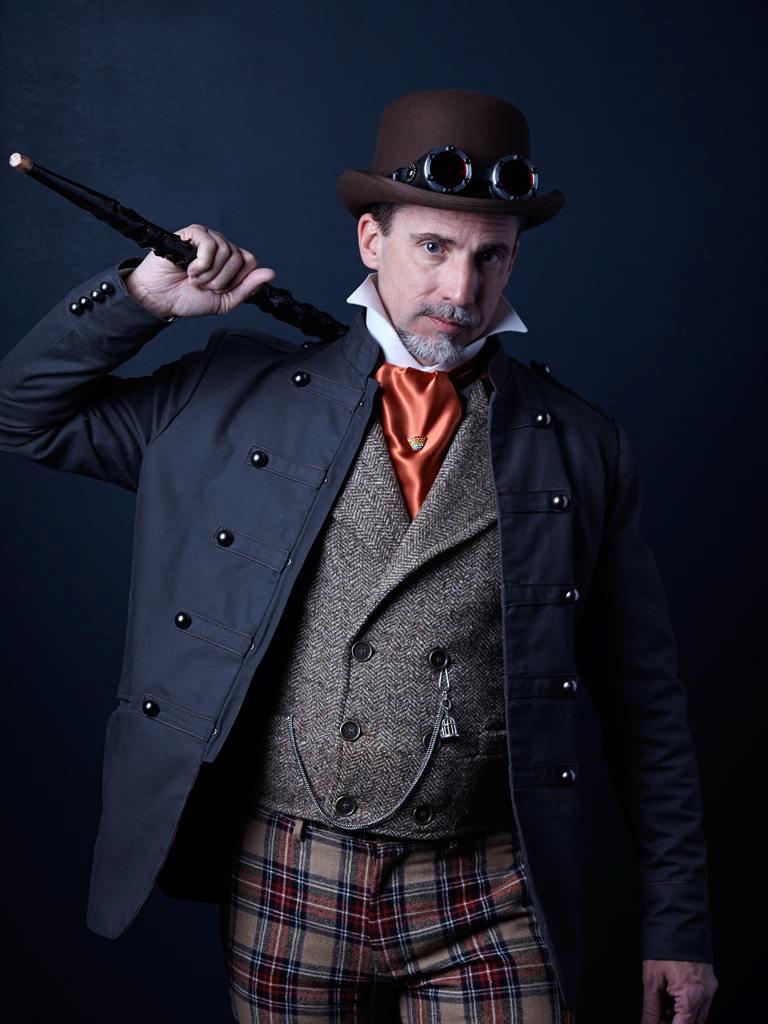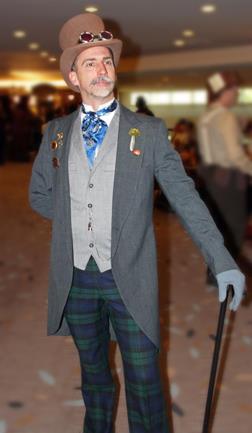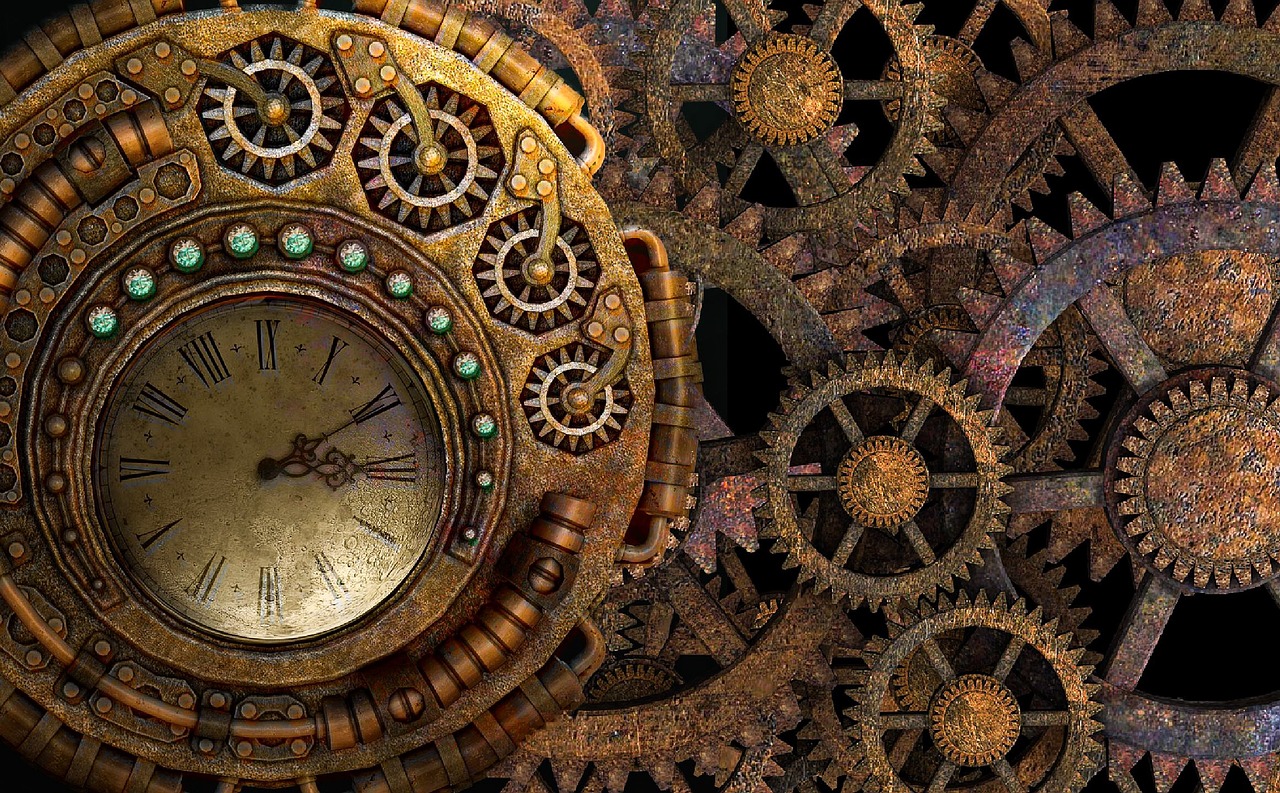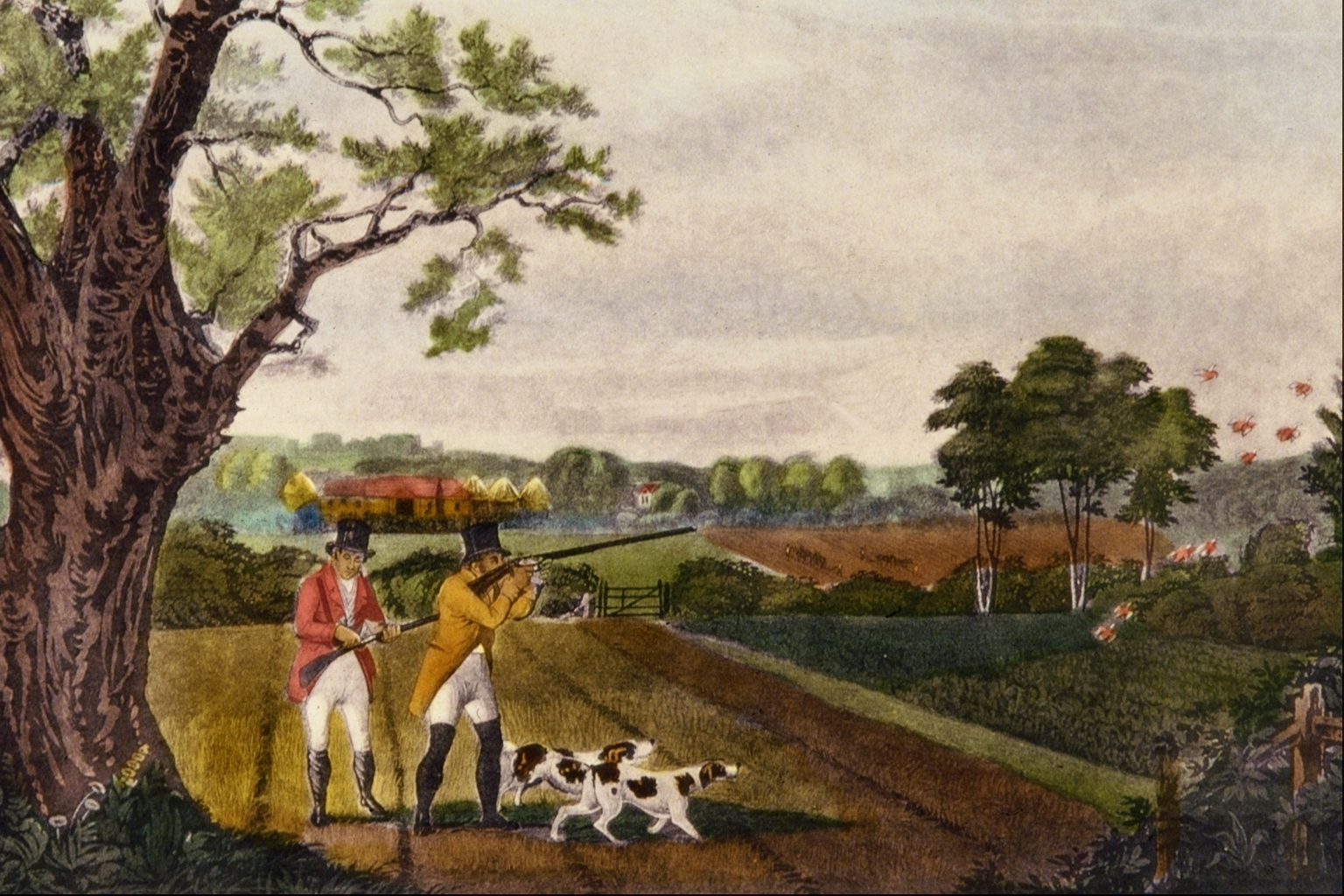Steampunk Transformation

How I went from a historic costumer to a Steampunk and loved it
by Kory Dean Doyle, First published in the July/August 2014 issue of Finery

It has been said there are as many definitions of Steampunk as there are people who call themselves Steampunks. There are those who will tell you what it is and it isn’t as if they are the only authority. There are others, however, that will say Steampunk is open to each person’s interpretation. I will share my own experiences coming into a movement that I once considered “cute” but wasn’t as “accurate” as historical, to becoming enthralled with it, and finding my own definition Steampunk style.
Background
I have been doing historical and science fiction costuming for 33 years. I began at 16 (you do the math) at the original Renaissance Pleasure Faire in Agoura, California. (Trust me, you don’t want to see my very first attempt!) I started with Elizabethans, both middle-class and courtly dress. Other periods include Saxon, Viking, English Medieval, Caviler, Restoration (and of course) Victorian and Edwardian; as well as science fiction costumes (Star Trek, Babylon Five, Star Wars, Doctor Who) and comic superheros. Under ICG costumer guild rules, I can compete as a master level costumer. I have run masquerades at Gallifrey One and at Loscon. I was nominated for Best-Dressed Steampunk Male by the Steampunk Chronicle Reader’s Poll in 2013 and won in 2014. I organized and ran a Steampunk fashion show for Clockwork Alchemy that received rave reviews not just for the innovative fashions shown, but the use of models of varying ages, sizes and ethnicities.
Now that I’ve established my costumer’s “street cred,” let me tell you how I got into Steampunk.
A former student told me that he was attending a Steampunk convention called Nova Albion. His enthusiasm about it picqued my interest enough that I decided to go. At that point, I had been out of the costuming and science fiction con scene for a while focusing on my education. I knew the basics of the genre and chose a late Victorian style outfit I had worn to previous Dickens Fairs. Upon arrival I noticed that I lacked an accessory that seemed ubiquitous to the look: goggles. After procuring a relatively inexpensive pair in the dealers’ room my look was complete and I set off for the convention. The longer I was there, the more I was struck by the enthusiasm, creativity, and welcoming attitude. Lo and behold! I found myself having more fun at a con than I had had in years. I was hooked.
Steampunk fashion is clothing that is inspired by the Victorian and/or Edwardian ages. It can be historically accurate but dressed with accessories that are of a more fantastical nature. It can also be an amalgam of the various styles from throughout the Victorian and Edwardian eras. To complicate the matter, for some Steampunks the genre is not a re-imagined past that never was but is, in fact, a postapocalyptic world where technology, society, and fashion, have turned their eye to the past to rebuild the future. In this interpretation, there can indeed be very little left of what some purists would call Victorian: all that remains is a corset, bustle, coat or top hat, but it is still very much Steampunk.
Confused? Don’t be. A good basic rule is to use Victorian/Edwardian silhouettes and fashions as the base and add or remove elements as one sees fit to create a look that is uniquely your own to fit a chosen role or persona, such as an airship pirate, mad scientist, daring explorer, or stylish lord or lady. This may also include military elements or even full uniforms of the period. Though the term “Victorian” is often used, don’t think that limits it to English fashions. Self-expression is what is at the core of developing your own Steampunk look be it based on English, French, German, American, Italian, Indian, or Japanese fashions. One may even combine all of them. Multi-culturalism is a force within Steampunk.

Now that we have some of the general visuals mulling about in our head, let’s address one of the most important parts of any Steampunk ensemble, accessories.
What is it with all the goggles?
Good question.
The actual origin of goggles being the defacto Steampunk accessory remains a mystery. One urban legend says that it is due to the heavy Steampunk attendance of Burning Man, where goggles are needed to shield eyes from the winds and sand. Some say that it is because of the early emphasis of airships in the genre. Michael Moorcock’s 1971 novel Warlord of the Air, considered by many as an early work of the genre, heavily featured airships. Still others point to the 1988 role playing game “Space: 1889” whose illustrations had most characters wearing goggles. Whatever the reason, goggles give the visual cue that a costume is Steampunk. Goggles can be inexpensive repainted plastic ski or welding goggles, or pricey unique eyewear of leather and brass.
But what if you don’t want to wear goggles? Well, another easy way is the use of fantastic gadgetry. Ray guns are not uncommon, neither is the use of plasma disks made to look like a power source for a gadget like a Steampunk inspired armature. I myself simply placed a repainted $3 LED reading light on my top hat. It’s not so much the amount you spend, but the effort and creativity to find the right look for you. See, how easy that was?

Steampunks are just Goths that discovered brown
While it could be argued that brown is the dominant color palate, it is not necessarily the only option. Like goggles, the origin of the dominance of brown is unknown. It’s possible that Captain Robert, the lead singer of the influential Steampunk band Abney Park, dresses predominantly in brown on stage, thus setting the fashion. There are those that have quietly rebelled against brown: I know a gentleman who dresses head-to-toe in purple. I, too, have gone for color; it has become one of my style signatures in Steampunk. I love that early Victorian menswear can be just as extravagant color wise as the ladies’ attire. The key for any Steampunk ensemble is to take what works for you and leave out what doesn’t. If brown is not your thing, don’t wear it. If you like the look, embrace it.
Just Glue Some Gears on it and Call it Steampunk
If there was any one symbol that is most used in the entire Steampunk movement, it would be the simple gear. The gear represents the industry and invention of the time. Making and gadgetry is a major part of Steampunk; thus, visible working gears show that a piece was not just mass manufactured, but made by an individual. As the movement grew, the gear transitioned from a functional piece to an aesthetic statement. Like goggles it became the visual cue that a costume was Steampunk. Many have derided the tendency of people either new to the movement or trying to make a fast buck by jumping on a trend to glue gears on a garment and declare, “Look, I’m Steampunk!” When done well, it can be a masterpiece. I recently saw a wedding dress that had over one hundred hand cut and appliquéd gears worked into the lace of the gown. For someone new to the movement, it’s the “gateway drug” as they discover their own style. Like goggles, you can take it or leave it. It’s up to you.
So for those who disdain Steampunk because “it’s not accurate,” don’t be so hasty in your judgment: there is a time and place for everything. When I attend an event that is touted as a historical recreation, I go in period dress. I make sure I am as accurate as possible while still making it wearable (I have a few physical limitations that need to be accommodated). However when I am going in Steampunk, each piece is usually historically accurate, though from different eras. Since there is such a broad time frame for Steampunk (generally the beginning of Victoria’s reign in 1837 to the death of Edward VII, 1910), I can wear an 1840s coat with 1900 trousers, an 1880s waistcoat and a 1910 tie. I did this exact look for a Steampunk costuming panel at Fanime 2011 and received praise for my elegant “man about town” ensemble by a young woman who was in what could be termed a Steampunk tank girl costume. She had done an amazing job of hand distressing and hand painting her creation that was worthy of equal praise in return. Sure, her look wasn’t “accurate,” but it showed remarkable skill.

I am by no means, an authority on what is or is not Steampunk, but as I became more and more involved in it, I find elements of Steampunk more incorporated into my everyday look. I’m obsessed with plaid, something I would have never worn in the mundane world before but now wear in a professional environment and have received compliments when I do. I look for any opportunity to wear a waistcoat, I have quite a collection of hats that I wear regularly. I spend more time on my grooming, and I’m more conscious of how I present myself. It is all part of the ideal being a gentleman, of bringing some of those courtesies and pleasantries that were the best parts of ‘a bygone era that never was’ to make our here-and-now a better place. That is truly one of the best parts of Steampunk and of costuming overall.



Leave a comment